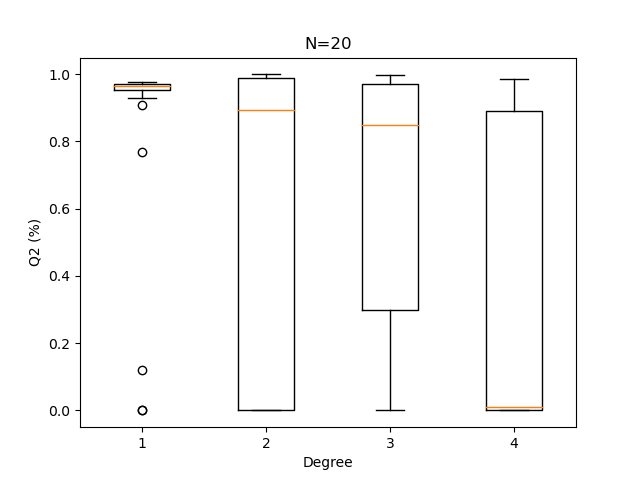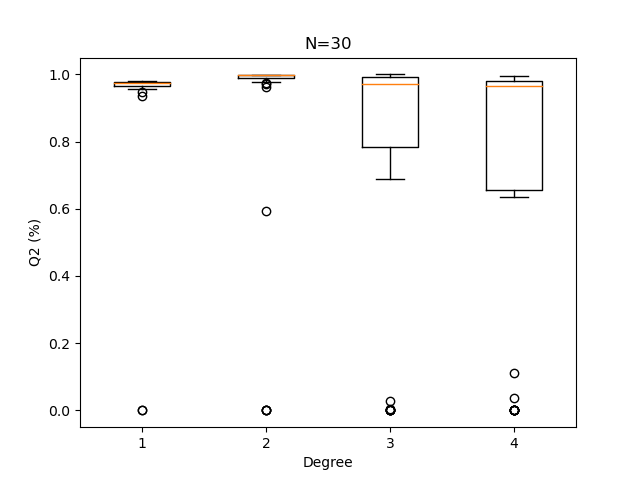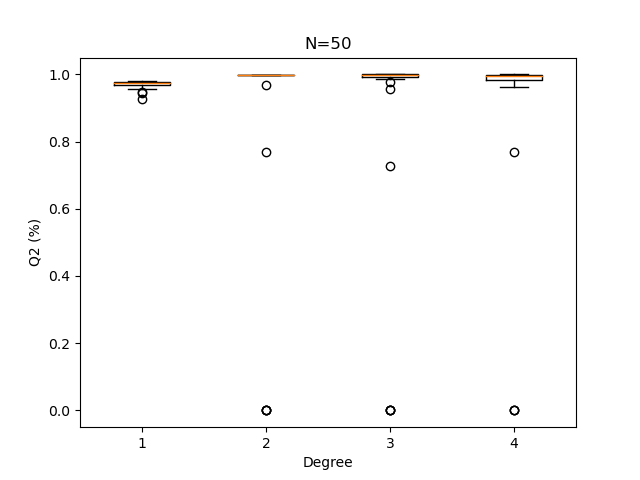Note
Click here to download the full example code
Polynomial chaos is sensitive to the degree¶
Introduction¶
In this example, we observe the sensitivity of the polynomial chaos expansion to the total degree of the polynomial. More precisely, we observe how this impacts the predictivity coefficient.
We consider the example of the cantilever beam. We create a sparse polynomial chaos with a linear enumeration rule and the family of orthogonal polynomials corresponding to each input variable.
import openturns as ot
import numpy as np
import openturns.viewer
import pylab as pl
The following parameter value leads to fast simulations.
maxDegree = 4
For real tests, we suggest using the following parameter value:
maxDegree = 7
Let us define the parameters of the cantilever beam problem.
dist_E = ot.Beta(0.9, 2.2, 2.8e7, 4.8e7)
dist_E.setDescription(["E"])
F_para = ot.LogNormalMuSigma(3.0e4, 9.0e3, 15.0e3) # in N
dist_F = ot.ParametrizedDistribution(F_para)
dist_F.setDescription(["F"])
dist_L = ot.Uniform(250.0, 260.0) # in cm
dist_L.setDescription(["L"])
dist_I = ot.Beta(2.5, 1.5, 310.0, 450.0) # in cm^4
dist_I.setDescription(["I"])
myDistribution = ot.ComposedDistribution([dist_E, dist_F, dist_L, dist_I])
dim_input = 4 # dimension of the input
dim_output = 1 # dimension of the output
def function_beam(X):
E, F, L, I = X
Y = F * L ** 3 / (3 * E * I)
return [Y]
g = ot.PythonFunction(dim_input, dim_output, function_beam)
g.setInputDescription(myDistribution.getDescription())
The following function creates a sparse polynomial chaos with a given total degree.
def ComputeSparseLeastSquaresChaos(
inputTrain, outputTrain, multivariateBasis, totalDegree, myDistribution
):
"""
Create a sparse polynomial chaos based on least squares.
* Uses the enumerate rule in multivariateBasis.
* Uses the LeastSquaresStrategy to compute the coefficients based on
least squares.
* Uses LeastSquaresMetaModelSelectionFactory to use the LARS selection method.
* Uses FixedStrategy in order to keep all the coefficients that the
LARS method selected.
Parameters
----------
inputTrain : ot.Sample
The input design of experiments.
outputTrain : ot.Sample
The output design of experiments.
multivariateBasis : ot.Basis
The multivariate chaos basis.
totalDegree : int
The total degree of the chaos polynomial.
myDistribution : ot.Distribution.
The distribution of the input variable.
Returns
-------
result : ot.PolynomialChaosResult
The estimated polynomial chaos.
"""
selectionAlgorithm = ot.LeastSquaresMetaModelSelectionFactory()
projectionStrategy = ot.LeastSquaresStrategy(
inputTrain, outputTrain, selectionAlgorithm
)
enumfunc = multivariateBasis.getEnumerateFunction()
P = enumfunc.getStrataCumulatedCardinal(totalDegree)
adaptiveStrategy = ot.FixedStrategy(multivariateBasis, P)
chaosalgo = ot.FunctionalChaosAlgorithm(
inputTrain, outputTrain, myDistribution, adaptiveStrategy, projectionStrategy
)
chaosalgo.run()
result = chaosalgo.getResult()
return result
The following function computes the sparsity rate of the polynomial chaos. To do this, we compute the number of coefficients in the decomposition assuming a linear enumeration rule and a fixed truncation. The sparsity rate is the complement of the ratio between the number of coefficients selected from LARS and the total number of coefficients in the full polynomial basis.
def computeSparsityRate(multivariateBasis, totalDegree, chaosResult):
"""Compute the sparsity rate, assuming a FixedStrategy."""
# Get P, the maximum possible number of coefficients
enumfunc = multivariateBasis.getEnumerateFunction()
P = enumfunc.getStrataCumulatedCardinal(totalDegree)
# Get number of coefficients in the selection
indices = chaosResult.getIndices()
nbcoeffs = indices.getSize()
# Compute rate
sparsityRate = 1.0 - nbcoeffs / P
return sparsityRate
The following functions compute and plot the Q2 predictivity coefficients within the validation plot.
def computeQ2Chaos(chaosResult, inputTest, outputTest):
"""Compute the Q2 of a chaos."""
metamodel = chaosResult.getMetaModel()
val = ot.MetaModelValidation(inputTest, outputTest, metamodel)
Q2 = val.computePredictivityFactor()[0]
Q2 = max(Q2, 0.0) # We are not lucky every day.
return Q2
def printChaosStats(multivariateBasis, chaosResult, inputTest, outputTest, totalDegree):
"""Print statistics of a chaos."""
sparsityRate = computeSparsityRate(multivariateBasis, totalDegree, chaosResult)
Q2 = computeQ2Chaos(chaosResult, inputTest, outputTest)
metamodel = chaosResult.getMetaModel()
val = ot.MetaModelValidation(inputTest, outputTest, metamodel)
graph = val.drawValidation().getGraph(0, 0)
legend1 = "D=%d, Q2=%.2f%%" % (totalDegree, 100 * Q2)
graph.setLegends(["", legend1])
graph.setLegendPosition("topleft")
print(
"Degree=%d, Q2=%.2f%%, Sparsity=%.2f%%"
% (totalDegree, 100 * Q2, 100 * sparsityRate)
)
return graph
multivariateBasis = ot.OrthogonalProductPolynomialFactory(
[dist_E, dist_F, dist_L, dist_I]
)
N = 20 # size of the train design
n_valid = 1000 # size of the test design
The seed is selected to get interesting results.
magicSeed = 43 # 127 is funny too
ot.RandomGenerator.SetSeed(magicSeed)
inputTrain = myDistribution.getSample(N)
outputTrain = g(inputTrain)
inputTest = myDistribution.getSample(n_valid)
outputTest = g(inputTest)
fig = pl.figure(figsize=(25, 4))
for totalDegree in range(1, maxDegree + 1):
chaosResult = ComputeSparseLeastSquaresChaos(
inputTrain, outputTrain, multivariateBasis, totalDegree, myDistribution
)
graph = printChaosStats(
multivariateBasis, chaosResult, inputTest, outputTest, totalDegree
)
ax = fig.add_subplot(1, maxDegree, totalDegree)
_ = ot.viewer.View(graph, figure=fig, axes=[ax])
pl.suptitle("Metamodel validation")

Out:
Degree=1, Q2=96.41%, Sparsity=20.00%
Degree=2, Q2=96.23%, Sparsity=46.67%
Degree=3, Q2=93.07%, Sparsity=71.43%
Degree=4, Q2=54.45%, Sparsity=94.29%
We see that when the degree of the polynomial increases, the Q2 coefficient decreases. We also see that the sparsity rate increases: while the basis size grows rapidly with the degree, the algorithm selects a smaller fraction of this basis. This shows that the algorithm performs its task of selecting relevant coefficients. However, this selection does not seem to be sufficient to mitigate the large number of coefficients.
Of course, this example is designed to make a predictivity decrease gradually. We are going to see that this situation is actually easy to reproduce.
Distribution of the predictivity coefficient¶
Let us repeat the following experiment to see the variability of the Q2 coefficient.
def computeSampleQ2(N, n_valid, numberAttempts, maxDegree):
"""For a given sample size N, for degree from 1 to maxDegree,
repeat the following experiment numberAttempts times:
create a sparse least squares chaos and compute the Q2
using n_valid points.
"""
Q2sample = ot.Sample(numberAttempts, maxDegree)
for totalDegree in range(1, maxDegree + 1):
print("Degree = %d" % (totalDegree))
for i in range(numberAttempts):
inputTrain = myDistribution.getSample(N)
outputTrain = g(inputTrain)
inputTest = myDistribution.getSample(n_valid)
outputTest = g(inputTest)
chaosResult = ComputeSparseLeastSquaresChaos(
inputTrain, outputTrain, multivariateBasis, totalDegree, myDistribution
)
Q2sample[i, totalDegree - 1] = computeQ2Chaos(
chaosResult, inputTest, outputTest
)
return Q2sample
The following function uses a boxplot to see the distribution of the Q2 coefficients.
def plotQ2Boxplots(Q2sample, N):
data = np.array(Q2sample)
fig = pl.figure()
pl.boxplot(data)
pl.title("N=%d" % (N))
pl.xlabel("Degree")
pl.ylabel("Q2 (%)")
return
Each experiment is repeated several times.
numberAttempts = 50 # Number of repetitions
N = 20 # size of the train design
Q2sample = computeSampleQ2(N, n_valid, numberAttempts, maxDegree)
plotQ2Boxplots(Q2sample, N)

Out:
Degree = 1
Degree = 2
Degree = 3
Degree = 4
We see that when the size of the design of experiments is as small as 20, it is more appropriate to use a very low degree polynomial. Here 1 performs best and 4 is risky.
N = 30 # size of the train design
Q2sample = computeSampleQ2(N, n_valid, numberAttempts, maxDegree)
plotQ2Boxplots(Q2sample, N)

Out:
Degree = 1
Degree = 2
Degree = 3
Degree = 4
With a 30-point design set, a polynomial degree of 2 is usually advisable.
N = 50 # size of the train design
Q2sample = computeSampleQ2(N, n_valid, numberAttempts, maxDegree)
plotQ2Boxplots(Q2sample, N)
pl.show()

Out:
Degree = 1
Degree = 2
Degree = 3
Degree = 4
When the sample size increases, the Q2 computation becomes less sensitive to the polynomial degree.
Conclusion¶
We observe that on the cantilever beam example, to use a polynomial total degree equal to 4, we need a sample size at least equal to 50 to get a satisfactory and reproducible Q2. When the degree is equal to 4, if the sample is small, then depending on the particular sample, the predictivity coefficient can be very low (i.e. less than 0.5). With a sample size as small as 20, a polynomial degree of 1 is safer. However the limited sample size may have an impact on other statistics that could be derived from a metamodel calculated on such a small training sample.
References¶
“Metamodel-Based Sensitivity Analysis: Polynomial Chaos Expansions and Gaussian Processes”, Loïc Le Gratiet, Stefano Marelli, Bruno Sudret, Handbook of Uncertainty Quantification, 2017, Springer International Publishing.
Total running time of the script: ( 0 minutes 13.526 seconds)
 OpenTURNS
OpenTURNS